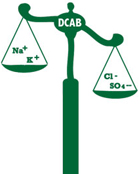All animals need a number of minerals in their rations for their body to function. Thanks to one hundred years of nutrition research, we know a lot about their requirement for individual minerals - whether it is sodium (salt), potassium or iodine. We know for example that it is rare for a horse to lack potassium, since plant foods are rich in this mineral. However, the amount of sodium in roughages is small in relation to the horse's requirements. This explains why we must give salt supplements, but not potassium supplements. Sodium and potassium are positive ions (cations), i.e. they have a positive electric charge, and will always be accompanied by an equivalent number of negative ions (anions), since a feed as a whole is without electrical charge. Similarly, when urine is excreted, it has no electrical charge, and must contain equivalent amounts of negative and positive ions to achieve this. Therefore, the dietary surplus of potassium and sodium is excreted together with negative ions such as chloride, sulphate which are also derived from the feed.

As already noted, the total amounts of these minerals in the ration are important for covering the bodily needs of the horse. In addition, the balance between sodium, potassium, chloride and sulphur (sulphate) in the ration has a special effect in determining the acid-base status of the body. This balance is called the “cation-anion balance” and is calculated as the sum of the positive ions minus the sum of the negative ions. The balance may be positive or negative depending on the amounts of sodium, potassium, chloride and sulphur in the ration.
Rations with a negative value for the cation-anion balance will create an acidic environment in the body. Rations with a positive cation-anion balance will counteract this acidification. All of this has led recently to increased interest in the area of cation-anion balance. In particular, sports-horses, eaters of large amounts of concentrates, are best served with a ration that has a mild alkalinizing effect. Feed producers can regulate the cation-anion balance of a feed through the addition of various salt supplements.
As important as the absolute amounts of sodium, potassium, chloride and sulphate, in the diet, is the balance (i.e. the difference) between the concentrations of these ions. Rations with a negative value for the cation-anion balance will create an acidic environment in the body. Rations with a positive cation-anion balance will counteract this acidification. All of this has led recently to increased interest in the area of cation-anion balance. In particular, sports-horses, eaters of large amounts of concentrates, are best served with a ration that has a mild alkalinizing effect. Feed producers can regulate the cation-anion balance of a feed through the addition of various salt supplements.
Complicated physiological processes underly the effects on the organism of the cation-anion feed balance. For those interested in learning more, we have attempted below to explain some of the background theory.
The acid-base balance of the horse's body is affected by the contents of electrolytes (especially potassium, sodium, chloride and sulphate or sulpur) in the food eaten. If there is an imbalance between the content of sodium and potassium, which are positive ions, and the content of chloride and sulfate ions, which are negatively charged, the body compensates through the secretion of hydrogen ions (acid) or hydrogencarbonate ions (base) in the urine. As a result of this, the urine pH value comes to deviate substantially from the blood pH value. Changes in urine pH take place throughout the day as a central part of the body's acid-base regulation system.
By analyzing the content of these electrolytes in the ration, we can calculate the effect of the ration on the horse's acid-base balance. The balance (i.e. the difference) between the content of positive and negative ions is called the cation-anion balance, usually abbreviated to DCAB or CAB. The cation-anion balance is not a nutrient, but a number, calculated on the basis of the levels of sodium, potassium, chloride and sulphur (sulphate) in the ration. DCAB can be calculated for a single feed, or for a days ration, and is expressed in milli-equivalents (mEq).
If DCAB is positive, the ration or feed contains an excess of potassium and sodium relative to chloride and sulfate. Such a ration will provoke an alkaline reaction in the body and hence the urine, as we commonly find with herbivores including horses. If DCAB is negative, the animal replaces the relative deficiency of sodium and potassium in its diet with acid (H+), and the urine becomes acidic. Carnivores such as dogs usually have a diet with negative DCAB and consequently they secrete acidic urine.
Sport horses are exposed to significant acid loads during vigorous physical activity. It is believed that rations with a beneficial cation-anion balance can help to buffer such acid loads, and thereby temporarily relieve their impact on the body. It is now increasingly common to provide information about the cation-anion balance of feeds, and to compose concentrates for sport horses in such a way that the total ration has a DCAB value of +200 to +300 mEq or higher. In PC-Horse you can keep an eye on the DCAB value of the ration and the individual meal. However, although there is no clear-cut advice on optimal DCAB values ??for horse rations available in the literature, there is general agreement that it is not desirable for rations to have negative DCAB values. Rations with negative DCAB will, if used for a long time, have detrimental effects, such as loss of calcium from the skeleton.